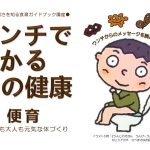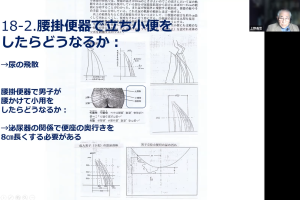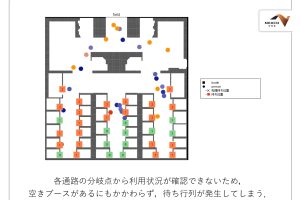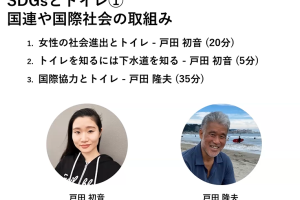The 12th seminar
“Infectious diseases and the environment”
– In order to correctly recognize the mechanism of infectious diseases
Japan Toilet Association (JTA) Seminar Series
Date: 21 April 2022 (Thu) 18:00-20:00 JST
Presenter: Toru Iyo, Ph.D., Part-time lecturer, Faculty of Health Sciences,
Bunkyo Gakuin University
Organizer:
Yoshihiko Kawauchi, Ph.D., Japan Toilet Association vice chairperson,
Former professor of Toyo University.
1. The History of Infectious Diseases
The infectious diseases are caused in the civilization and society.
It cannot cause illness even though simply there is a pathogenic microorganism.
It will become an infectious disease, only when there is a condition with the transmitting and propagating pathogenic microorganisms. The history of “Infectious Diseases” is beyond the existence of human being and it actually changed the history of mankind.
The excrements and urines were used as the fertilizer for the agriculture, and then they were not discarded in the antient days. Once the potty was used in Europe and threw them out of the window during the dark night. The infectious diseases such as the plague and cholera were frequently outbroken. Europe was covered with glaciers at the ice age and the topsoil was stripped. Only grass can grow as the land is no nutrition. The excrements and urines were not used as the fertilizer since the livestock industry used the grass as the feed. Then deterioration of sanitation due to the excrement and urine contamination in the city became a serious problem.
The steam engine was invented at the Industrial Revolution age. It creates a harsh working environment for workers as a result, and workers’ illnesses widespread eventually since it endlessly worked during day and night. The average life time of the upper class was 35 years old and the merchant was 22 years old in the middle of the 19th century in Manchester, England. The worker died at the age of 15 years old before 20. The mortality rate of upper-class infants was 20%. The half of Manchester workers’ infants died before their five years old.
2. The Cases of Infectious Diseases
The first case is that an infectious disease such as the cholera often caused by unsanitary treatment of the excrements and urines. The vibrio cholerae was discovered in 1884. It becomes sick in a few days less than five days when infected. The probability of human-to-human transmission is unlikely. The infection occurs by the water and food. It causes diarrhea 20 to 30 times a day with vomiting. They die finally by dehydration. Ultimately, replenishment of water and electrolytes are the curing method. There is no vaccine. It causes tragedy if one has not correct knowledge on the pandemic of infectious diseases. It is a problem to be indifferent to the crisis management, but it is also a problem to have an excessive sense of the crisis due to the reports of medias. It is important to properly select from many information and consider by oneself in crisis management, not just infectious disease prevention.
The second case is the tuberculosis. The tuberculosis can also be found in prehistoric human bones 5000 BC. As the urbanization progress of the Industrial Revolution, the tuberculosis became a pandemic and it was called “White Plague.” When comparing Japan and the world in terms of the current number of tuberculosis deaths per 100,000 population, they are extra ordinally high ratio in Japan. This is currently a serious problem as a re-emerging infectious disease.
The third case is leprosy. It was subject to discrimination and human rights abuses although the tuberculosis was not. It has been misunderstood as a genetic disease because of its very long incubation period but its infectivity is weak. The patients were discriminated because it is a disease of the body rotted with its bad odor. The beriberi is an example of a misunderstanding of an infectious disease. Vitamin B1 thiamine deficiency causes the swelling of the lower limbs due to the heart failure, and occur sudden cardiac arrest in the worst case. The death toll of beriberi was 28,000 of malnutrition at the Russo-Japanese War. 46,000 soldiers died at the Siege of Port Arthur. It tells us a large number of soldiers died of malnutrition.
3. The Countermeasures against the Infectious Disease
The infection is defined as the invasion of a pathogen into the body to do involvement. The incubation period is defined from the infection to the onset. Even if infected, there are two situations of an overt infection or the subclinical infection. So called the opportunistic infection is usually harmless with non-pathogenic microorganisms. Basically, all microorganisms are infectious, and they become active when the human body condition is weaker. The infection can only be determined by the symptoms since it cannot be proved that the patient is not infected the disease. For example, in the case of the influenza, it is said that the patient can go out by three days after the fever is normal, but actually some patients keep the flu virus even after three days. Therefore, it is hard to prove as negative.
The three infection factors depend on the transmission route, the infectivity pathogens power, and the ability of resistance of the body. Infection is active only when these three factors are established. The most important infection control measures are the hand washing, disinfection and vaccination. The hand washing is effective to block the transmission route, and disinfection is effective to eliminate the infectivity of pathogens. The improving immunity contributes to empower the body’s resistance. It depends on the vaccination, well sleeping, taking the nourish foods and regular defecation as well as the moderate exercise and mental health.
We live daily in a society with an average lifespan of 80 years owing to the vaccine. The medicine is also properly effective. Wearing mask is also effective for blocking the infection route, but the mask prevents mainly droplet infection to others rather than to prevent from infecting oneself. Wearing the mask, hand washing and disinfection are also effective to block the infection route. The purpose of the hand washing is to remove skin-passing bacteria and viruses that adhere to the skin surface. There is a skin indigenous flora barrier and if it is washed too much, the skin barrier must be weakened.
Infectious diseases are classified into following five categories;
Category 1 The infectious are extremely dangerous ones.
Category 2 The infectious are also at high risk. The tuberculosis is included in this category. COVID-19 infection is also included.
Category 3 The infections outbreak sometimes, such as cholera, dysentery, bacterial dysentery, enterohemorrhagic Escherichia coli infection (O157), typhoid fever, and paratyphoid fever.
Category 4 The infection is a zoonotic. It is not possible human-to-human transmission, but animal-to-human transmission. Very dangerous one is the rabies, which kills 100% when infected.
Category 5 The infection is transmitted from human-to-human. A typical example is the influenza, which is prevalent every year.
In addition to these categories, there is designated as a new influenza. The designated period is two years and must be terminated by early next year.
Aside from those ones, there are designated infectious diseases. The cabinet order will announce it for one year period, when there occurred a high risk of an infectious disease. There is also a designation of a new infectious disease. It has an extremely high risk of being transmitted from human-to-human and is designated as a new infectious disease. This is during designated one-year period.
The water route infectious diseases can be prevented not only by the medicine but also by the water purification and the good-quality water supply. The under the age of one mortality rate decreases when the water supply penetration rate increases. The water supply maintenance is also effective to prevent the infectious diseases. It can be said that the good water supply maintenance prevents the diseases in Japan. The water we daily drink must contribute significantly to the improvement of the public health.
4. COVID-19
The randomized controlled trials (RCT) will be applied to verify the vaccine effect. Without informing the subject whether they are vaccinated or placebo, fix the same number of days and participants, and observe the proportion of affected patients. Then compare the inpatients of vaccinated or non-vaccinated. The number of hospitalized people occupy spontaneously the majority since 80% are vaccinated now. Now the vaccination can be considered to prevent aggravation rather than to prevent infection. Therefore, the infection prevention activity is still necessary even if vaccinated. Some data inform that the new positives per 100,000 population decrease owing to three times vaccinations. There are many new positives who have not been vaccinated although relating to the aging matter.
There are many hoaxes in COVID-19.
Someone says that Japanese Government measures against COVID-19 failed, but it must be successful to have taken measures without the blocking the city. The number of infected people is small about one-tenth to one-hundredth comparing with the foreign countries. It is completely fake information that the existence of the virus has not been confirmed or that it changes the human gene. Someone says it is only catching a cold, but actually it is a serious pneumonia. The aftereffects will often keep remaining. Some people are mildly cured, but others have serious symptoms. The safety is an issue of the science, and security is an issue of the sensibility or emotion.
It is easier to convince emotionally to simply tell dangerous rather than to tell by the scientifical safety. The website of the Ministry of Health, Labor and Welfare is a good source to get the related information. The volunteered doctors disseminate information; “Cobi Navi” (https://covnavi.jp/) .
The hygiene measures are basically simple. Wash your hands, disinfect, gargle, and wear a mask considering the balance between the inconvenience and the social life. The main point is not to spread splashes, ventilate room and stay at home.
In summary, it is important to be careful not to accumulate stress, to have a good sleep, to take the nourish foods, regular defecation as well as the moderate exercise, rest if not feeling well, and do not overdo. It is also necessary to get a vaccination to boost immunity. The infectious diseases are actually an invisible threat, and there were various superstitions such as filth and grudges in the past. Even now, there are rumored words, hoaxes, biased information, claims and incitement. It is necessary to acquire accurate scientific knowledge and information and take measures against infectious diseases faithfully based on the basics.
【Q&A】
[Q1: Kawauchi] What is the relationship between the toilet and the COVID-19?
[A1: Iyo] There seems to be a considerable correlation between the sewage and the infection.
I think it is a right idea to target the affected patient.
The current type of COVID-19 virus infection has a very wide base. It is desirable to identify asymptomatic and mild cases by PCR test. But I think it is important for the doctor to diagnose this person as having an onset or suspected infection.
There are both false positives and false negatives in the test and this may lead the test unnecessarily. I think the best is to follow the instructions from your doctor or health center. Some people are tested before returning home or traveling, but the test cannot prove to be truly negative. Even if it is positive condition, it might be indicated as negative, so I think it is best to purely check your physical condition.
[A2: Iyo] The bacteria and virus countermeasures are commonly familiar at home. However, it is necessary to be careful at the toilets at work place or in public places where the bacteria and viruses are carried by the other people. Keep in mind to wash your hands when you get out of the toilet where bacteria and viruses may survive. The effect of washing your hands will be lost if you touch the door knob even after washing your hands.
I think the best is always to wash your hands not only in toilet but also anywhere. The toilet holds bacteria and viruses brought by other people, then the washing action of your hands means for others. The supermarket staffs often wear gloves but many various bacteria and viruses will stick to them. After someone touches things and leaves bacteria and viruses, they move the glove of the cash register, and then they move to the things I bought. The gloves are effective tool for people who are suffering from the rough hand skin as the personal protection. [Q3: D] Is the soap essential for the hand washing? Is there any alternative way that cleans it well?
[A3: Iyo] According to the information from the Ministry of Health, Labor and Welfare, if you wash your hands with running tap water for 15 seconds, the virus on your hands will be reduced to about 1/100. If you use soap, it can reduce even more. The soap is not essential, but it works well. The Ministry of Health, Labor and Welfare announces that disinfection is not necessary if you wash your hands with soap. [Q4: Kawauchi] In your lecture today, there is a barrier called higher fatty acid on the surface of the skin. However, if we wash it too much with soap etc., it may break the barrier. Then it is better to use running water for 15 seconds because it will not break the barrier?
[A4: Iyo] That is a matter of degree. Even if you wash it with soap for about a minute, I don’t think the barrier cannot break so much. Don’t worry to wash with the soap when there is. [Q5: K] How is the effect of gargling against COVID-19?
[A5: Iyo] I have not really surveyed the effect of gargling. I think it’s better to do it than not to do. When I come back to home, I rinse my mouth once and then take a shower to clean my body and hair. The gargling may cause the droplets to spread, but if there are no pathogens in them, there will not be particular problem. It is important to keep clean the toilet by wiping or disinfecting after using it. [Q6: M] I heard in the case of the norovirus, that if we close the lid of the toilet bowl and let the water flow, the droplets will not spread. How about the effect?
[A6: Iyo] In fact they are different issues that the virus is detected in feces or sewage and that it is infectious. There is also data that COVID-19 in toilet feces is less infectious. It may be effective to prevent splashes by closing the lid of the toilet bowl and flushing. But I think the best is to get out of the cubicle soon after. [C7: K] I work for a sanitary equipment manufacturer company. I think that there are many problems with infection because the conventional Japanese crouching style toilets spread a lot of splashes, but the current bowl style toilets will not much. [Q8: Hi] Is there any institution having data on the rate at the patients with muscular disease, muscular dystrophy or spinal muscular atrophy become severely condition or die when infected with COVID-19?
[A8: Iyo] There is a lot of information on the websites of the Patients’ Association of muscular dystrophy and diseases. A research project by the Ministry of Health, Labor and Welfare states that there must be no problem with the vaccination of COVID-19 for the muscular dystrophy. I think the reports from the Patients’ Association and the research group of the Ministry of Health, Labor and Welfare are the most reliable.
I’m not a specialist in this field, but it is important to recognize the reason of the problem occurs, and then consider the risks between vaccinated or not comprehensively.
I think the paradox is a patient who are treated with the immunosuppressive drugs can get immunity by vaccination. According to the report of the research group of the Ministry of Health, Labor and Welfare, it is concluded that the effectiveness can be expected even in such a situation. [Q9: M] Some nursery center blocks the air flow in the nursery room and the toilet.
I think that the ventilation design must be applied with a negative pressure to the toilet room. Moreover, there are some cases with a strict instruction to have a door. Is it effective for the norovirus or COVID-19?
[A9: Iyo] I think that such a guideline has been established based on the results of examinations by the Ministry of Health, Labor and Welfare and related administrative agencies. However, often children move actively even if they wear masks. Then it spread immediately the infection among children, even though simply block the air flow from the toilet. There is a highly risk that children will bring it into the home and cause a domestic infection. I think this is a difficult problem to solve. [Q10: M] I am not convinced because it is regulated only at the staff in charge before the evidence is not clear.
[A10: Iyo] Check whether the standard defines the application place. If not, the nursery teacher should consider about it. [Q11: M] When it is said that the child’s life is the first importance, the nursery teachers cannot say anything more.
[A11: Iyo] The experiment is only the way of getting the evidence. We do not know what the children are doing in the toilet or they defecate there. We will discuss these matters together and find what we can do. [Q12: M] After the government order becomes absolute, it is no longer allowed to argue in the public. I expect the infectious disease expert will explain to the government and tell that some portion can be allowed to decide by the public.
[A12: Iyo] Why don’t you contact the Ministry of Health, Labor and Welfare and ask. I think that various talks will start from consulting with related parties such as the country, the cities, and the Tokyo Metropolitan Government. [Q13: Kawauchi] There are various transmission routes such as contact infection, droplet infection, and aerosol infection in the case of COVID-19, and which route would you think is the most susceptible to infection route?
[A13: Iyo] The infection route is one factor. There are the other factors such as the amount of virus and the resistance of the body. The contact, droplets, and aerosols are all considered to be about the same level as the propagation means. The thing is not to pay attention the most susceptible but consider well balance between the inconvenience of infection control and the economy of the society.










